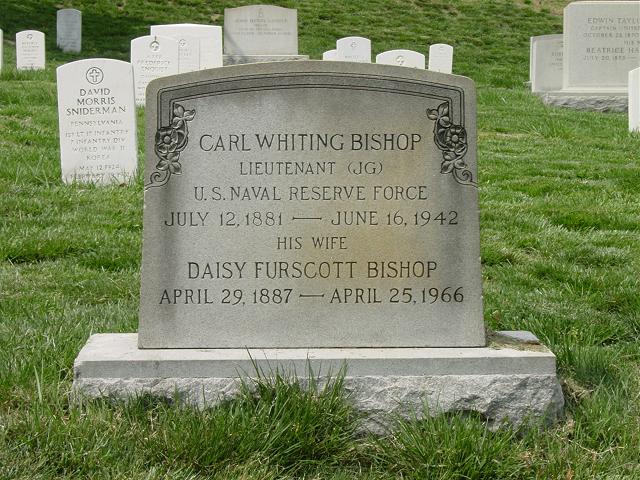Archeologist – Smithsonian Institution
Thanks to Bryan Hagon for sending along information on his great uncle for inclusion here. Thanks also to Keith Barnes, Arlington National Cemetery, for helping to fill in some of the blanks.
Born on June 12, 1882, the son of Charles Bishop (1850-1941), a Methodist Missionary in Japan, he was educated at DePuaw University, Greencastle, Indiana, and at the Hampden-Sidney College, Farmville, Virginia. He married Nettie E. Brooks on February 24, 1909 in Tarrytown, New York. He apparently married a second time to Daisy F. Bishop.
He was Silver Assayst in Mexico during the Yacqui uprisings there in 1905-06; was an Intelligence Officer with the United States Naval Reserve Force from October 2, 1918 until his discharge on October 1, 1922, serving in China in 1919 (as evidenced by a letter that he wrote during this time to his sister – Bryan’s grandmother). Thereafter he served at the Smithsonian Institution for twenty years prior to his death on June 18,1942. At the time of his death, the Smithsonian announced: “His contribution to the pre-history of China and Japan interpreted in the light of his extensive knowledge of the interplay of geography and culture, are among the most important ever made.”
He lies buried in Section 8 (Grave 6216), in the shadows of the Pentagon and the Navy Annex and at the end of Eisenhower Drive in Arlington National Cemetery. His second wife, Daisy, was buried with him on April 29, 1966.
Additional information provided by Brooks Bishop Gernerd, December 2002:
Born on June 12, 1881 in Tokyo, he was the son of the Reverend Charles Bishop (1850-1941) and Olive Whiting (1847-1914) Methodist missionaries in Japan.
He lived in Tokyo until he was 16 and attended the English School, from 1888 to 1897. In 1898 he came to America and finished his pre-college education at Northwestern Academy, Evanston, Illinois. He received his AB degree from DePauw University, Greencastle, Indiana in 1912 and his Masters degree from Colombia University (Department of Anthropology) in 1913. As an undergraduate, he also attended Hampden-Sydney College, Hampden-Sydney, Virginia, and Business College, Poughkeepsie, New York.
He married Nettie Elizabeth Brooks (1893-1933) on February 24, 1909 in Tarrytown, New York. They had six children — Olive Elizabeth Bishop Nelson 1910-1992, married Jourdan Wheeler Nelson, no children; Charles Whiting Bishop, 1911-1954, married Elizabeth Connelly, no children; John Stephen Bishop, 1914-1938, never married, no children; George Bishop, 1916-1916; Leicester Brooks Bishop, 1919-1970, married Phyllis Virginia Johnson, three children; Brooks Bishop Gernerd, 1949-, married Frederick Holden Gernerd, one child; Elisabeth Brooks Gernerd, 1988 -; Gordon Griffith Bishop, not married, no children; Leicester Brooks Bishop, Jr., 1957-, married Deborah Ours, one child, Victoria Brooks Bishop, 1989 -; Maude Anstis Bishop Pollock, 1922 – , married Frederick Anderson Pollock, three children; Stephen Whiting Pollock, 1953-; b. James Bishop Pollock, 1956 -; Scott Brooks Pollock, 1957.
He married his second wife, Daisy Furscott. They did not have any children.
He began his career in archaeology as a member of the Peabody Museum Expedition to Central America.
From 1914-1918 he was Assistant Curator of Oriental Art at the University of Pennsylvania Museum, and as a member of that staff made his first trip to China from 1915-1917. For his archaeological work in China, he was made a member of the University of Pennsylvania chapter of Sigma XI.
In 1918 Bishop enlisted in the United States Navy and became the Assistant Naval Attache in China until 1920 with the rank of Lieutenant, Junior Grade.
He served as a professor in archaeology to Colombia University from October, 1921 to April, 1922 whereupon be became Associate Curator at the Freer Gallery of Art, Smithsonian Institute, Washington, D.C. for the next twenty years, nine of which were spent in China, until his death on June 18, 1942.
At the time of his death, the Smithsonian announced: “His contribution to the pre-history of China and Japan interpreted in the light of his extensive knowledge of the interplay of geography and culture, are among the most important ever made.”
He was a member of a number of learned societies: the American Oriental Society, since 1917; the American Archaeological Society, Anthropological Society, Washington, D.C.; the American Society for the Advancement of Science; and at the time of his death on the Advisory Board for the American Council of Learned Societies in Washington, D.C.
He lies buried in Section 8 (Grave 6216), in the shodows of the Pentagon and the Navy Annex and at the end of Eisenhower Drive in Arlington Natinal Cemetery. His second wife, Daisy, who assisted him with his work in China, was buried with him on April 29, 1966.
CARL W. BISHOP
Archeologist at Smithsonian 20 Years – Served Navy in War
ALEXANDRIA, Virginia, June 16, – Carl Whiting Bishop, archaeologist at the Smithsonian Institution for the last twenty years , died in a hospital today after a three-week illness,. His age was 60.
A graduate of De Pau and Columbia Universities, he taught archaeology at Columbia before joining the Columbia staff. He was a Lieutenant in the Naval Intelligence Service during the First World War.
Burial will be in Arlington National Cemetery Thursday.
BISHOP, CARL WHITING
United States Navy
VETERAN SERVICE DATES: 10/02/1918 – 10/01/1922
DATE OF DEATH: 06/16/1942
DATE OF INTERMENT: 06/18/1942
BURIED AT: SECTION 8 SITE 6216
ARLINGTON NATIONAL CEMETERY
BISHOP, DAISY F
DATE OF BIRTH: 04/29/1887
DATE OF DEATH: 04/25/1966
DATE OF INTERMENT: 04/29/1966
BURIED AT: SECTION 8 SITE 6216
ARLINGTON NATIONAL CEMETERY
Michael Robert Patterson was born in Arlington and is the son of a former officer of the US Army. So it was no wonder that sooner or later his interests drew him to American history and especially to American military history. Many of his articles can be found on renowned portals like the New York Times, Washingtonpost or Wikipedia.
Reviewed by: Michael Howard

